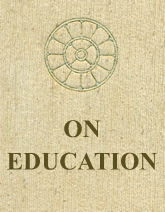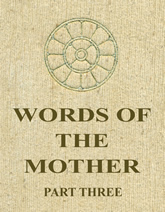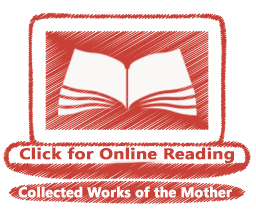


Sweet Mother,
How should we read your books and the books of Sri Aurobindo so that they may enter into our consciousness instead of being understood only by the mind?
To read my books is not difficult because they are written in the simplest language, almost the spoken language. To get help from them, it is enough to read with attention and concentration and an attitude of inner good-will, with a desire to receive and live what is taught.
To read what Sri Aurobindo writes is more difficult because the expression is highly intellectual and the language far more literary and philosophic. The brain needs a preparation to really be able to understand and generally this preparation takes time, unless one is specially gifted with an innate intuitive faculty.
In any case, I always advise reading a little at a time, keeping the mind as quiet as one can, without making an effort to understand, but keeping the head as silent as possible and letting the force contained in what one reads enter deep inside. This force, received in calm and silence, will do its work of illumining and will create in the brain, if necessary, the cells required for understanding. Thus, when one re-reads the same thing some months later, one finds that the thought expressed has become much clearer and closer and even at times quite familiar.
It is preferable to read regularly, a little every day and at a fixed hour if possible; this facilitates the brain's receptivity.1
There are the very few who want to understand life, its purpose and its goal. For them, Sri Aurobindo's books are the best reading of all.2
By carefully reading what Sri Aurobindo has written on the subject, develop a clear conception of what human perfection must be.
By closely observing your own character, become aware of what needs to be transformed in order to achieve the ideal condition. Then set to work sincerely, observing your inner as well as your outer movements. And each time you discover something that contradicts the ideal you have set for yourself, make an effort to correct it.3
The Mother
Ref: 1.CWM 17:231, 2. Ibid., p.359, 3. Ibid., p.39



Reading also can be made helpful.1
You can remember at the beginning and offer your reading to the Divine and at the end again. There is a state of consciousness in which only a part of it is reading or doing the work and behind there is the consciousness of the Divine always.2
Dedication to the Divine [is the right attitude in reading]. To read what will help the Yoga or what will be useful for the work or what will develop the capacities for the divine purpose.3
All should be done quietly from within―working, speaking, reading, writing as part of the real consciousness―not with the dispersed and unquiet movement of the ordinary consciousness.4
At the top of the head or above it is the right place for Yogic concentration in reading or thinking.5
It is quite natural to want to meditate while reading
Yogic literature.6
This [inclination to meditate while reading books on
spiritual life] is quite a normal movement. In reading
these books you get into touch with the Force behind
them and it is this that pushes you into meditation and
a corresponding experience.7
When the passion for reading or study seizes hold of the mind, it is like that; one wants to spend all the time doing it. It is a force that wants to satisfy itself―like other forces―and takes hold of the consciousness for its purpose. One has to utilise these forces without letting them take hold; for this there must be the central being always in control of the forces of Nature that come to it, deciding for itself the choice of what it shall accept, how use, how arrange their action. Otherwise each Force catches hold of some part of the personality (the student, the social man, the erotic man, the fighter) and uses and drives the being instead of being controlled and used by it.8
Reading good books can be of help in the early mental stage―they prepare the mind, put it in the right atmosphere―can even if one is very sensitive bring some glimpses of realisation on the mental plane. Afterwards the utility diminishes―you have to find the right knowledge and experience in yourself.9
What you can do is to read not for pastime but with the clear intention of furnishing your mind with knowledge.10
Yes, reading can be done for the improvement of the mental instrument as part of the sadhana.11
That [inability to understand what is read] only means that you cannot separate yourself from your mental consciousness in its activity. Naturally, if you take your mental consciousness off the reading, you can't understand what is being read, for it is with the mental consciousness that one understands. You have not to make the mental consciousness separate from the reading, but yourself separate from the mental consciousness. You have to be the Witness watching it reading or writing or talking, just as you watch the body acting or moving.12
Sri Aurobindo
Reference: 1. CWSA 31:63, 2. Ibid., p.64, 3. Ibid., p.63, 4. Ibid., v29, p.254, 5. Ibid., p.311, 6. Ibid., p.318, 7. Ibid., v31, p.63, 8. Ibid., p.62, 9. Ibid., p.63, 10. Ibid., p.64, 11. Ibid., p.64, 12. Ibid., p.65

The Complete Works of Sri Aurobindo (CWSA)
The Complete Works of Sri Aurobindo (CWSA) in a uniform library edition consist of 37 volumes―36 volumes are available and volume no.37 is to be published (Ref: sriaurobindoashram.org). CWSA is published by Sri Aurobindo Ashram Publication Department, Puducherry, India.
All available (36 volumes) PDF files of the Complete Works of Sri Aurobindo (CWSA) can be downloaded from sriaurobindoashram.org website. Please check copyright with Sri Aurobindo Ashram Trust, Puducherry, India.
| Volume 1 |
 |
Early Cultural Writings |
| Volume 2 |
 |
Collected Poems |
| Volumes 3-4 |
 |
Collected Plays and Stories — I–II |
| Volume 5 |
 |
Translations |
| Volumes 6-7 |
 |
Bande Mataram — I–II |
| Volume 8 |
 |
Karmayogin |
| Volume 9 |
 |
Writings in Bengali and Sanskrit |
| Volumes 10-11 |
 |
The Record of Yoga — I–II |
| Volume 12 |
 |
Essays Divine and Human |
| Volume 13 |
 |
Essays in Philosophy and Yoga |
| Volume 14 |
 |
Vedic and Philological Studies |
| Volume 15 |
 |
The Secret of the Veda |
| Volume 16 |
 |
Hymns to the Mystic Fire |
| Volume 17 |
 |
Upanishads-I : Isha Upanishad |
| Volume 18 |
 |
Upanishads-II : Kena and Other Upanishads |
| Volume 19 |
 |
Essays on the Gita Essays on the philosophy and method of self-discipline presented in the Bhagavad Gita. These essays were first published in the monthly review Arya between 1916 and 1920 and revised in the 1920s by Sri Aurobindo for publication as a book. |
| Volume 20 |
 |
The Renaissance in India with A Defence of Indian Culture Essays on the value of Indian civilisation and culture. This volume consists of three series of essays and one single essay: (1) "The Renaissance in India", (2) "Indian Culture and External Influence", (3) "Is India Civilised?" and (4) "Defence of Indian Culture". They were first published in the monthly review Arya between 1918 and 1921. In 1953, they first appeared in a book under the title The Foundations of Indian Culture. |
| Volumes 21-22 |
 |
The Life Divine — I–II |
| Volumes 23-24 |
 |
The Synthesis of Yoga — I–II |
| Volume 25 |
 |
The Human Cycle — The Ideal of Human Unity — War and
Self-Determination |
| Volume 26 |
 |
The Future Poetry with On Quantitative Metre |
| Volume 27 |
 |
Letters on Poetry and Art |
| Volume 28 |
 |
Letters on Yoga — I |
| Volume 29 |
 |
Letters on Yoga — II |
| Volume 30 |
 |
Letters on Yoga — III |
| Volume 31 |
 |
Letters on Yoga — IV |
| Volume 32 |
 |
The Mother with Letters on the Mother |
| Volumes 33-34 |
 |
Savitri — A Legend and a Symbol |
| Volume 35 |
 |
Letters on Himself and the Ashram |
| Volume 36 |
 |
Autobiographical Notes and Other Writings of Historical Interest |
| Volume 37 |
Reference Volume (TO BE PUBLISHED) |
|
|
Glossary to the Record of Yoga (TO BE PUBLISHED) |

The Collected Works of The Mother (CWM)
The Collected Works of The Mother (CWM) in a uniform library edition of 17 volumes is published by Sri Aurobindo Ashram Publication Department, Puducherry, India.
The 17-volume Collected Works consists of nine volumes of talks and eight volumes of writings (prayers, reflections, essays, sayings, letters and personal notes). Most of the material was written or spoken in French and appear here in translation. The text on the Sri Aurobindo Ashram website is that of the second edition; it is textually the same as the first edition (excepting a few minor corrections), but differs in page numbering.
Online reading of the Collected Works of the Mother (CWM) is available on the website sriaurobindoashram.org.
CONTENTS OF THE COLLECTED WORKS
| Volume 1 |
 |
Prayers And Meditations |
| Volume 2 |
 |
Words of Long Ago |
| Volume 3 |
 |
Questions and Answers 1929–1931 |
| Volume 4 |
 |
Questions and Answers 1950–1951 |
| Volume 5 |
 |
Questions and Answers 1953 |
| Volume 6 |
 |
Questions and Answers 1954 |
| Volume 7 |
 |
Questions and Answers 1955 |
| Volume 8 |
 |
Questions and Answers 1956 |
| Volume 9 |
 |
Questions and Answers 1957–1958 |
| Volume 10 |
 |
On Thoughts and Aphorisms |
| Volume 11 |
 |
Notes on the Way |
| Volume 12 |
 |
On Education |
| Volume 13 |
 |
Words of the Mother |
| Volume 14 |
 |
Words of the Mother |
| Volume 15 |
 |
&p align="justify">Words of the Mother Short written statements on Yoga and life: the Divine and the universe, adverse forces, religion, occultism, morality, war, wealth, government, transformation, illness and health, messages, prayers and talks. |
| Volume 16 |
 |
Some Answers from the Mother |
| Volume 17 |
 |
More Answers from the Mother |




